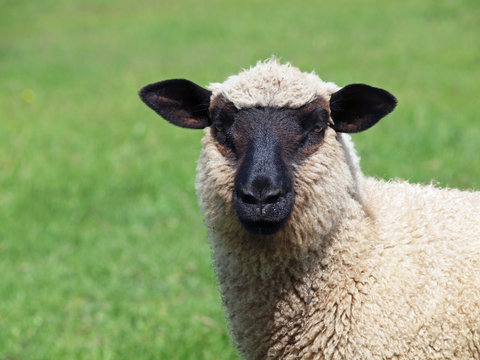The Suffolk is a British breed of domestic sheep. It originated in the late eighteenth century in the area of Bury St. Edmunds in Suffolk, as a result of cross-breeding when Norfolk Horn ewes were put to improved Southdown rams. It is a polled, black-faced breed, and is raised primarily for its meat. It has been exported to many countries and is among the most numerous breeds of sheep worldwide.
History
The Suffolk originated in the area surrounding Bury St. Edmunds in Suffolk in the late eighteenth century, as a result of cross-breeding when Norfolk Horn ewes were put to improved Southdown rams. They were at first known as Blackface or Southdown-Norfolks; the first use of the name “Suffolk” for these sheep dates to 1797. In 1810 it was recognised as a distinct breed but was not known by the present name until 1859. A breed society, the English Suffolk Society, was formed in 1886; a flock book published in the following year recorded some 15,000 ewes. By the end of the nineteenth century, the Suffolk had displaced the Oxford Down as the principal terminal sire used on cross-bred ewes in Scotland. By the 1980s breed numbers in the United Kingdom had risen to some 500,000 head, but later fell.
The Suffolk has been exported to many countries including Australia, Austria, Belgium, Brazil, Canada, Czechoslovakia, France, Germany, Italy, Kenya, the Netherlands, New Zealand, Portugal, South Africa, Spain, and the United States, and has become one of the most numerous sheep breeds in the world. It was introduced to the USA in 1888 by one G.B. Streeter of Chazy, New York. A large and long-legged sub-type has developed there; it is fast-growing, but the carcase is of lower quality.
Characteristics
The Suffolks are a common breed of domestic sheep. They are polled and have black open faces along with black legs and white-woollen bodies. Suffolks are considered a large breed of sheep, their size and colouring originate from their Southdown heritage. Their large frame and muscular bodies make them an ideal breed for meat production, however; they are also good for wool production. They are hardy sheep, a trait originating from their Norfolk Horn heritage.
Suffolk rams are commonly used as a terminal sire on cross-bred ewes due to their ability to produce offspring with excellent growth and carcass traits.
Spider lamb syndrome is most common in the Suffolk breed.
